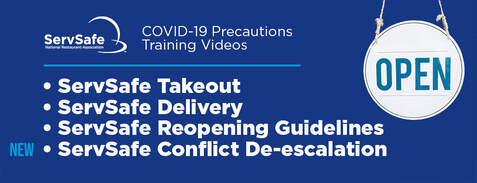The Ultimate Guide to Becoming a Certified ServSafe Food Handler in Your State
The Ultimate Guide to Becoming a Certified ServSafe Food Handler in Your State
Blog Article
Comprehensive Food Handlers Training for Health and Safety
In today's rapidly evolving food service landscape, thorough food trainers training has become a vital part for ensuring health and safety. By instilling crucial practices related to hand health, food storage space, and sanitation, this training not only reduces the risk of foodborne health problems however also reinforces compliance with governing criteria. The implications of such training expand beyond simple compliance; they discuss public health and wellness and consumer count on. Yet, the efficiency of these training programs can differ significantly. What aspects truly determine their success in promoting a culture of safety and security?
Value of Food Safety And Security Training

Additionally, food safety training helps to ensure that workers know current guidelines and standards, which are essential for keeping operational licenses and staying clear of pricey penalties. Routine training sessions additionally function as a platform for enhancing best methods, therefore decreasing the possibility of human mistake, which typically acts as a leading reason for food contamination.
Moreover, purchasing food safety and security training can improve an establishment's credibility, as customers progressively focus on eating experiences that reflect high safety criteria. Such positive actions not only safeguard customers however additionally add to the lasting success of food businesses. In summary, extensive food safety and security training is an important component of food solution operations, directly impacting both public health and service sustainability.
Trick Concepts of Health
Maintaining high requirements of health is essential in any food taking care of setting to avoid contamination and make sure the safety of customers. The vital principles of hygiene encompass several essential methods that food trainers have to continually apply.
First, hand hygiene is vital; food trainers ought to wash their hands thoroughly with soap and water prior to and after taking care of food, in addition to after using the washroom or touching any potentially contaminated surfaces. Equipment and surfaces must be consistently cleaned and disinfected to remove virus. This consists of tools, cutting boards, and counter tops, which must be kept in a clean problem.


Correct food storage space is likewise vital; raw foods should be stored separately from prepared or ready-to-eat products to prevent cross-contamination. servsafe alcohol. In addition, preserving suitable temperature controls is crucial; disposable products should be maintained at secure temperature levels to prevent microbial development
Finally, personal health can not be ignored. Food handlers should use clean clothing, usage hair restrictions, and stay clear of working when ill. By sticking to these crucial principles of health, food trainers can dramatically lower the risk of foodborne ailments and advertise a safer eating experience for all consumers.
Usual Foodborne Health Problems
Although many foodborne health problems can be avoided through appropriate health and safe food managing techniques, they stay a significant public health and wellness problem. Foodborne microorganisms can lead to a range of health problems, ranging from light intestinal distress to serious problems and even death.
Usual foodborne diseases consist of salmonellosis, created by Salmonella bacteria, usually connected to undercooked fowl and eggs. Another common health problem is listeriosis, related to raw dairy read this products and ready-to-eat meats, which can be specifically dangerous for immunocompromised people and expectant females. Norovirus, frequently contracted from polluted food or surfaces, is understood for its quick spread and capacity to create outbreaks in communal settings.
Escherichia coli (E. coli) infection, notably connected with undercooked hamburger and infected produce, can cause severe stomach cramps and kidney failing in some situations. Furthermore, Clostridium perfringens, commonly located in huge quantities of food that are incorrectly kept, can trigger food poisoning with symptoms appearing quickly after usage.
Recognizing these ailments is essential for food trainers, as recognition can significantly reduce the danger of contamination and secure public health. Proper education and training are vital parts in combating foodborne illness.
Finest Practices for Food Handling
Efficient food dealing with practices are vital in preventing the spread of foodborne ailments. Correct hand health is essential; food handlers must clean their hands thoroughly with soap and water before and after dealing with food, especially raw meat or chicken. This basic action significantly lowers the risk of cross-contamination
Second of all, keeping ideal food storage space temperatures is important. Consistently disinfect countertops, cutting boards, and utensils, specifically after preparing raw foods. Use separate cutting boards for raw and ready-to-eat foods to further reduce contamination threats.
Additionally, when preparing food, it is very important to comply with the principle of "very first in, first out" (FIFO) to handle supply properly i was reading this and lower spoilage. Finally, always review and stick to foodstuff labels for risk-free cooking temperatures and handling instructions. By implementing these best techniques, food handlers can considerably improve food safety and security and secure public health and wellness.
Carrying Out a Safety Society
Producing a security culture within a food managing atmosphere is necessary for fostering a dedication to food security among all employee. This society highlights the value of food safety as a common duty, motivating workers to focus on hygiene techniques regularly.
To implement a safety and security culture, organizations should start by providing extensive training that addresses food handling procedures, potential risks, and the significance of individual health. Educating sessions must be interactive and tailored to the specific roles of team members, making certain relevance and interaction.
Moreover, leadership plays an essential function in developing this society. Monitoring ought to design secure techniques and communicate the value of food safety and security frequently. Identifying and rewarding employees who support safety and security requirements can further strengthen these habits.
In addition, open interaction channels need to be developed, allowing personnel to report safety problems without worry of consequence. Regular safety and security audits and responses sessions can help determine locations for enhancement and reinforce responsibility.
Eventually, cultivating a security society not just boosts conformity with food safety and security laws however additionally shields public wellness, fosters staff member spirits, and adds to the general success of the food dealing with establishment.
Final Thought
In verdict, detailed food handlers training plays a critical duty in promoting hygiene and safety within food solution establishments. By gearing up workers with necessary knowledge about food safety concepts, typical foodborne diseases, and best techniques for dealing with food, such training considerably reduces wellness risks. Cultivating find more information a culture of safety and security improves the facility's credibility and straightens with consumer assumptions for high safety and security criteria, eventually adding to public health and wellness security and the overall success of the food solution industry.
In today's swiftly progressing food service landscape, detailed food trainers training has actually emerged as a vital element for ensuring health and safety.Food safety training is vital for maintaining high standards in food handling and preparation, with research studies showing that proper training can minimize foodborne health problems by up to 30%. In recap, extensive food security training is a vital component of food service procedures, directly affecting both public wellness and organization sustainability.

Report this page